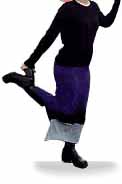

In order to understand the rising interest in tarot collecting,
you might want to brush up on the history of tarot. According to the
Salem Tarot site, the designs
of the 22 cards in the Major Arcana go back as far as 1440 in Italy,
and were meant as a card playing game for Nobles. It wasn't until centuries
later that the cards were used for divination purposes. In 1781,
Antoine Court de Gebelin theorized that the cards were a lost key
to Egyptian magical wisdom. Later around the nineteenth century,
the occultist Eliphas Levi made a connection between the tarot and the
Hebrew system of mysticism called the Kabbalah.
It seems as tarot cards gained popularity in each century,
certain secret societies designed their own decks to fit their
own symbolism and needs. However, tarot decks were yet to be used
by the mass public. In the 20th century, Arthur Edward Waite
commissioned artist Pamela Coleman Smith, to create a deck
that is now considered to be the most popular deck among beginners.
Most tarot readers consider Waite's deck to be a "learning deck"
because of its simplistic symbols and design.
"Many teachers of the tarot will tell you to pick the deck
that most resonates with your personal artistic tastes and spiritual
leanings. I think that this is often true," Christian Day of Salem
Tarot explains. "For beginners, however, I usually recommend the Rider
Waite tarot as their first deck simply because it has the most written
about it. Newcomers to the tarot will find many books explaining virtually
every aspect of the symbolism contained within Waite's classic deck.
Once the basics of this deck are understood, finding a set that suits
your personality is welcomed and advised. I still use the Rider Waite
after 12 years because I like the symbolism."
If you already know the symbols of all 78 cards of the tarot,
and can give a reading with ease, buying a specialty deck can be
a treat. Collector Tom Tadfor Little of Santa Fe, N.M., has over
80 tarot decks in his vast collection. On his Web site,
the Hermitage: A Tarot History,
he explains the background history about many of his decks, most
of which happen to be vintage and rather rare.
"Personally, I love the old decks, especially the elegant
Italian ones that do not have too much explicit occult symbolism.
I relate to the tarot pictures mostly as archetypes or allegories,
so I don't have much need for symbolism that needs to be 'decoded,'"
Little explains. "If one is really interested in 'authenticity' and
perhaps exploring the mindset of the time when the tarot was first
invented, then of course the old decks are more useful. One also needs
to keep in mind that before 1910, tarot decks with pictorial scenes on
all 78 cards were virtually non-existent. The minor arcana cards in
the old decks just used geometric arrangements of the suit symbols,
like ordinary playing cards do."
Of all the rare decks Little has come across in his collecting,
he suggests buying a few modern decks with a variety of spiritual
or artistic themes. His favorite vintage choices include an authentic
tarot de Marseille deck, the Visconti-Sforza cards and one of the
Italian variant tarots, like the Minchiate or Tarocco Siciliano.
"Don't just collect the tarot. Learn the symbolism," Day suggests.
"The tarot is a picture book that reflects many spiritual and
historical facets of the culture in which it evolved. There is
much to learn about ourselves and the world from its pages."
Whether you’re a beginner or an advanced hobbyist, there's
no shortage of decks to start collecting. Tarot decks seem to
have their own personalities and histories behind them, so do
your homework and become familiar with the artists and the
companies who create them. Bonnie Burton, creator of Grrl.com, writes about dating dilemmas, online auction addictions and Internet culture for various magazines and Web sites including MissClick, Wired, Yahoo! Internet Life and Excite@Home.